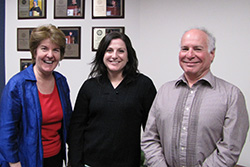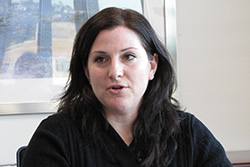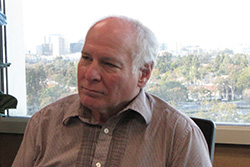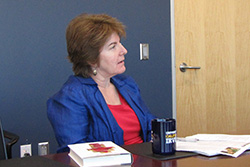Celebrating the passion, dedication and personal stories of Social Ecology faculty, staff, students, alumni and benefactors, “The Dean Asks…” is a feature in which Dean Valerie Jenness interviews people inspired by the pursuit of excellence and encourages participation in interdisciplinary education to solve complex societal problems. Over the next year, please check back to read or listen to additional installments. View Archive
 Valerie Jenness, Dean of the School of Social Ecology, interviewed graduate student Lindsey Stuvick and Professor David Feldman about their research on water sustainability. Both Stuvick and Feldman are leading efforts to improve the sustainable use of water locally and internationally.
Valerie Jenness, Dean of the School of Social Ecology, interviewed graduate student Lindsey Stuvick and Professor David Feldman about their research on water sustainability. Both Stuvick and Feldman are leading efforts to improve the sustainable use of water locally and internationally.
Jenness: We are going to talk with both of you about water. I thought I would start by literally putting this right between us, which is bottled water. Tell me what it evokes for you.
Stuvick: Unnecessary. I'm primarily looking at the plastic bottle. It isn’t necessary, in my opinion. I find water to be interesting because everybody needs water and everybody has a stake in it. In the management of water, the public is not brought in to the conversation as much as it should be. Other things I find interesting about water management are institutional barriers and how to adapt management structures to be more efficient. The organizational and sociological aspects of water are what I find particularly fascinating.
I got interested in water because I grew up in the Chino Valley, which was home to the largest dairy operation in the US until the 1980s. A lot of animal waste deposits would get into the groundwater and there was a huge issue with water quality. Growing up in that area we would get letters from the local water supplier informing you that nitrates were found in your water, but to not worry about it. The community would get upset, and you start to wonder where the community’s voice is in the issue? Who manages our water? How do I get involved? It was something that we talked about in my family. The letters stopped after a while because the technology finally caught up to the pollution. Now they are able to better manage it and there are region-wide watershed coalitions that are working on these things. Also, the government has more stringent requirements for water quality.
Jenness: Dave, in the School of Social Ecology, you are our top water researcher. You have two books recently published about water, you have a big National Science Foundation (NSF) grant with an international focus, and you're publishing in Science, which is a premier periodical for social scientists and natural scientists. What's your reaction to the bottled water?
Feldman: A couple things come to mind. First, it is a privatized commodity, and yet water is an absolute human necessity. For thousands of years, most of us have assumed that water was such a necessity that it should be free, if not extremely cheap. Yet we are living in a society that has turned it into a private consumer item. We pay an exorbitant amount of money for this bottle of water; it's about 600 times more expensive than tap water. As a social scientist, one of the questions I ask is why we do this, particularly in a developed country like the United States? A lot of it comes down to convenience, but it also comes down to a lack of public trust over the safety of public water supplies.
Also, it takes approximately eight times as much water to create this bottle than the amount of water that's actually in it. It takes water to produce the energy to transport it, to pump it out of the ground, and to filter it. Also, water was used to manufacture the plastic.
The other thing I see is tremendous waste. There are whole parts of our oceans in which you can actually see islands made out of discarded plastic bottles, and they don't biodegrade. This plastic probably can't be recycled. It's really a tragedy. In places like Long Beach they actually have nets at the end of the Los Angeles River, trash racks, that collect hundreds of tons of municipal waste a month. Much of that waste collected is comprised primarily of these bottles.
It is a real social problem in terms of privatization, control and power, equity, and the environmental externalities caused by generating that bottle of water.
 Jenness: Could both of you talk about how your training and the current point in your career helped shape how you see these issues.
Jenness: Could both of you talk about how your training and the current point in your career helped shape how you see these issues.
Stuvick: I did my undergraduate degree in political science. I enrolled in the Regenerative Studies graduate program at Cal Poly-Pomona because I was interested in studying resource production methods - extraction, manufacturing, distribution, consumption, and finally disposal - underlying all of that is profit. Regenerative Studies examines these linear production models and tries to close those loops. Part of that involves reducing the use of resources or reusing them in some way, but beyond that, we research sustainable ways to support communities, often by mimicking natural processes.
For my thesis in Regenerative Studies, I decided to look at gray water in homes. Graywater, as opposed to black water, which is toilet water, is water that is not too soiled – such as sink or shower water. It can be reused in your home. For example, you can reuse your shower water to water plants or flush the toilet. It is a really interesting talking piece, because it brings up people's insecurities about public health, environmental health and public trust. When I first started my research in 2009, I assumed that I should talk to city planners about this, because it's happening in people's homes and they should know about it. What I found out was that planners don't know anything about gray water, mostly because of the political and bureaucratic lines that divide water management. You have the Department of Water Resources, which cares about water resources and supply and you have the State Water Resources Control Board, which cares about water quality and the legal/administrative parts. My concern was that I have all these really cool ideas coming from Regenerative Studies to start integrating water and land use planning to make sustainable communities, but there are bureaucratic and institutional barriers to doing this. So I decided to follow up with a second Master's degree in planning and really implement my regenerative theory.
Jenness: Interesting. Dave, how do you see your training and career shaping your view of water?
Feldman: When I was finishing graduate school, I was nominated for a Presidential Management Fellowship, which gave me the opportunity to look at various job possibilities for Federal or state agencies. Because of this fellowship, I got a call from the Director of the Water Resources Planning Program at the Missouri Department of Natural Resources. He told me that they had a federal grant from the Carter administration to develop a state water plan (they and all 50 states). Jimmy Carter tried to do something quite unprecedented, which ties in to what Lindsay was saying, to actually create a national water policy to coordinate water supply, water quality, river basin planning, and resolving conflict between states. Missouri was at the confluence of about six major river basins, so it was an extraordinary opportunity. They needed somebody to help them write a state water plan, which he described to me as a policy document. I was a trained political scientist, not a water guy. He made me a deal: go there and share what I knew about policy and they would teach me what I needed to know about water. So I worked on helping to write the state water plan on an interdisciplinary water resources team that was made up of hydrologists, engineers, urban planners, geographers. It was just a tremendous experience.
 Jenness: What is your single biggest concern about water, given that you both have these different backgrounds, but you operate on a similar intersection?
Jenness: What is your single biggest concern about water, given that you both have these different backgrounds, but you operate on a similar intersection?
Stuvick: It is twofold. A lot of our water sources have already been tapped and the marginal cost of getting additional units of water are increasing. Marginal cost in this case refers to financial costs, human costs, and energy costs. Energy cost is particularly concerning because San Diego just passed their desalination plant plan. I read an article today that said we use 20% of our energy right now just to import water. If all of the coastal cities, where the majority of the population lives, transitions to desalination, we will expend 50% of the state's total energy use going towards acquiring water.
The second part of what I am concerned about is the need for a cultural shift. In my research at Cal Poly, I have done a lot of interviews with different water agencies. When I talk to the people in places like the Central coast or the Bay Area, they are trying to get their water usage down to under 100 gallons per capita per day--and they are close to it. This is unheard of in places down south, such as the inland empire, where it is about 220 per capita per day.
Jenness: So for you, it is not just about cost. It is also about availability and surplus, even if we are willing to pay the cost.
Stuvick: Yes, even if we are willing to pay the cost. People will find ways to come up with the money to get it. That is why I went into the planning aspect of water. For example, you need to know when a new development is coming in and be able to provide water equity for the people that are already living there. There are social justice questions and transitioning culture questions to research. This is one of the reasons why I started looking into the advanced water conservation strategies in Australia, which originated from a national water initiative almost 10 years ago.
Jenness: What are the stakes for us? So far they sound gigantic. Dave, what would you say is the number one issue?
Feldman: I think for me the number one challenge is that for the first time in human history we are now faced with the fact that freshwater is a limiting factor in the furtherance of public health and well-being. Throughout history, when we needed water, we could divert it from someplace that didn't need it to somplace that did. It was so cheap and so abundant that we simply didn't worry about the cost, and we didn't really worry about the impact on the environment or its availability. In fact, it became a marker of civilization, how successfully a society could harness its water. That was the foundation for much of politics in the ancient world.
Now, because of climate change, population growth, urbanization, and demand for food and fiber, water is now a limiting factor throughout the world, and we're faced with extremely hard choices globally, nationally, and even locally. Here in California, we are now at the point where we are going to have to decide do we want to be the largest agricultural producer in the United States (we currently produce about 40% of the nation's vegetables) or do we want to continue to subsidize the growth of ridiculously large cities in the Southwest that don’t have a good water source, like Phoenix and Las Vegas?
Jenness: You really see this as kind of a historic moment, not just a kind of economic or cultural or equity moment.
Feldman: Yes. I think the World Bank put it in a way that was both frightening but accurate: that for the 21st century, water is the energy crisis of our era. It is frightening because we know how we dealt with energy. The answer is we didn't.
 Jenness: Where is the public debate, consternation, and alarm around water?
Jenness: Where is the public debate, consternation, and alarm around water?
Feldman: I think the public is acutely unaware of water and its problems. What gets the public fired up is any incident in which there is a public health threat.
Jenness: Dave, you are saying that the public debates are not happening. Lindsey, why is it not there? How do you make sense of this?
Stuvick: I think the problem is that people don't understand the true value, such as economic value, of water because it has been subsidized and historically has been readily available.
Jenness: Where are our academics doing translational work and work in the public domain?
Stuvick: I definitely think you are going to see it soon. We are at fork in the road. Either we go with the status quo and treat water like we treated energy, which is not address it really at all, or make a radical change. People might have to pay a little bit more. This is starting to happen, actually. Water agencies are coming up with water budgets and tiered water rates, which increase their rates, and consequeently force people to change the way they think about and consume water.
Jenness: Are you anticipating we will see that dialogue emerge in the public?
Stuvick: Yes, because people will potentially be upset about new rates.
Feldman: We see this happening already in places like the Murray-Darling Basin in southwestern Australia, where they have had year after year of drought and farmers are desperate for water. The cities that require that same water supply are desperate to get a dependable supply. Now it is starting to register with the public that they have a responsibility for working with public officials to figure out a way to manage it as a scarce resource that can be reclaimed. Gray water doesn’t have to flow into the ocean. You can recycle it and treat it as a renewable, reusable resource.
Stuvick: Right, exactly. Water sensitive urban design, which is something that we're just starting to require here, is like low-impact development and regional storm water management. But there is always the struggle of getting people to do it. Even though they are very centralized, there still has to be an adaptive type of management to incorporate things, build capacity and be flexible.
I want to see how Australia did it. Where they hit the wall? Where did they have successes? How did their communication and collaboration operate? Is any of that transferable? Because I've heard in the water industry many, many times, the technology is there, the capital is there. But the institutional barrier is there.
Jenness: Dave, how do you approach that kind of odd nexus that Lindsey describes?
Feldman: For me, it kind of goes in two directions. I've done a lot of work, as Lindsey knows, on adaptive management. I'm very much impressed by the ability to solve problems by low-impact development, whether it means finding ways to do more with less- such as recycling water, recirculating it, reusing it, and reclaiming it. Instead of building large water projects which force the migration of millions of people, like in China and India, you figure out ways to use less water through -low-impact methods that have a smaller environmental footprint.
I see a lot of evidence that it's happening, but for me, there's another approach that goes off in a little bit different direction and that is the important role of leadership. I have two examples. First, 50 years ago in California, Pat Brown was probably the principal architect for the entire United States for how a governor can work with the legislature and various stakeholder groups to cooperate and move forward together. Governor Brown was really a revolutionary leader in being able to engineer something that, frankly, today I don't think we could do it in California. We had half as many people, but he came up with a plan that was not just an engineering plan. I mean, people think this issue is just moving water from the north to the south via the state aqueduct. It was much more than that. It was a political and economic compromise. It was basically saying that the state would provide a system for managing water that would try to promote regional equity and the accommodation of economic growth in different sectors that would benefit the entire commonwealth. It takes a special leadership effort. Pat Brown didn't say you are going to be better off because of this project. Instead, he said that it is your children and grandchildren that will be better off because of the decisions we are making in 1962.
A second example of this is in the Middle East. Israel and Palestine can agree on very little, but beginning in the late 1990s, they agreed on something called the Joint Water Initiative, which basically manages the groundwater and surface waters of Palestine and Israel as a conjoint resource. If there's any disruption in water supply or water treatment systems in any West Bank village, Israeli or Palestinian, the closest utility authority will respond and fix the problem. In the words of the agreement, which was formulated under what's called the Oslo Accord of the United Nations, “the management of water will be removed from the cycle of violence.” Why are they willing to do that? Because both sides know that regardless of their differences, water is absolutely essential to sustaining their communities. This is a very critical leadership issue, and it's not being done by national leaders but by mayors and city council members. These leaders are very pragmatic; they can sit together and, despite political and ideological differences, manage their water supply.
As you can see, adaptive management and leadership are both very important.
 Jenness: I know you are at different stages in your career, but tell me where you go from here.
Jenness: I know you are at different stages in your career, but tell me where you go from here.
Stuvick: I would like to stay here in California. I have been working a lot with the local watershed, such as the Santa Ana River Watershed. California is very progressive in regards to water and is a focal point of innovative watershed planning.
Jenness: Dave and I were just in a meeting where we were ruminating on what the School of Social Ecology’s core values are and what we aspire to do. Dave wants to make sure community impact is front and center in our mission statement. The plan that you have would be a demonstration of this. You are a person who did interdisciplinary training and then came back and worked in our communities and contributed. I wish you all the best in that.
Stuvick: Thank you. I appreciate that.
Jenness: Dave, where do you go from here? I know you just got this big collaborative grant with the National Science Foundation, and you have these two books on water coming out. Now what?
Feldman: For me, one of the things I am really fascinated with for a number of years now is the technical innovations developed by engineers and other technologists, such as the low energy water production and re-use approaches we are looking at with the NSF grant. Various techniques for reclaiming wastewater, for encouraging conservation and reuse, water use efficiency, all of these sorts of things.
We know all of these techniques and engineering novelties work. But for me, the next step is looking at the social justice implications of these technologies. Who's paying for them, who's benefiting from them, what risks do they impose upon certain populations, and what inequities do they generate in different communities?
In Orange County, we recycle about 40% of our wastewater and much of it, in places like Irvine Ranch Water District, become our potable water supply. That is a good thing. Los Angeles and San Diego have failed to do this. Why? a legacy of environmental injustice. People do not trust the water provider institutions.
Jenness: We are right back to where we began when you first commented that water, for you, was at this nexus between people and their trust in government or lack thereof. It is an interesting time to ask our public institutions to do the work of the public, especially if we don't trust them or like them.
Thank you both.